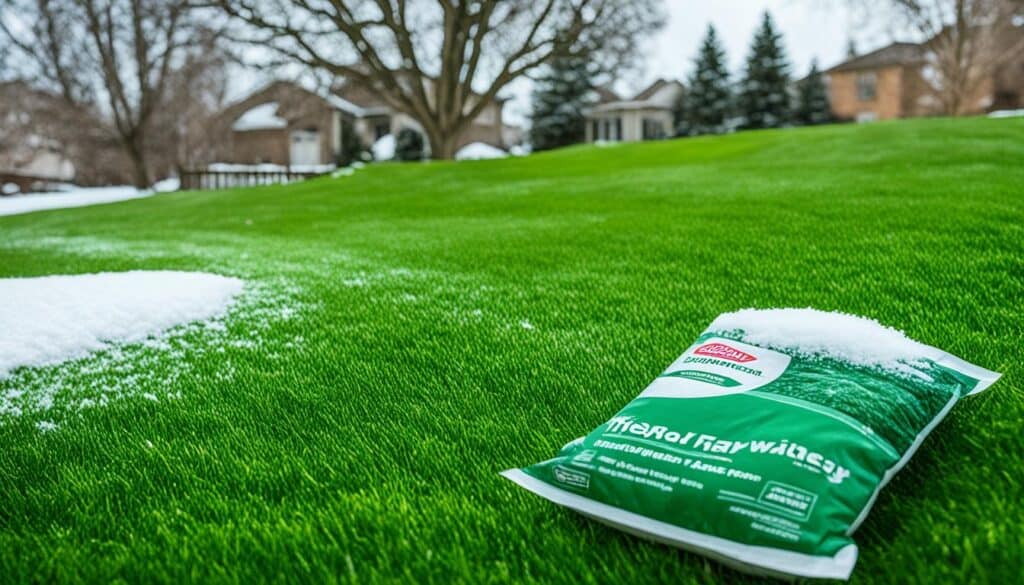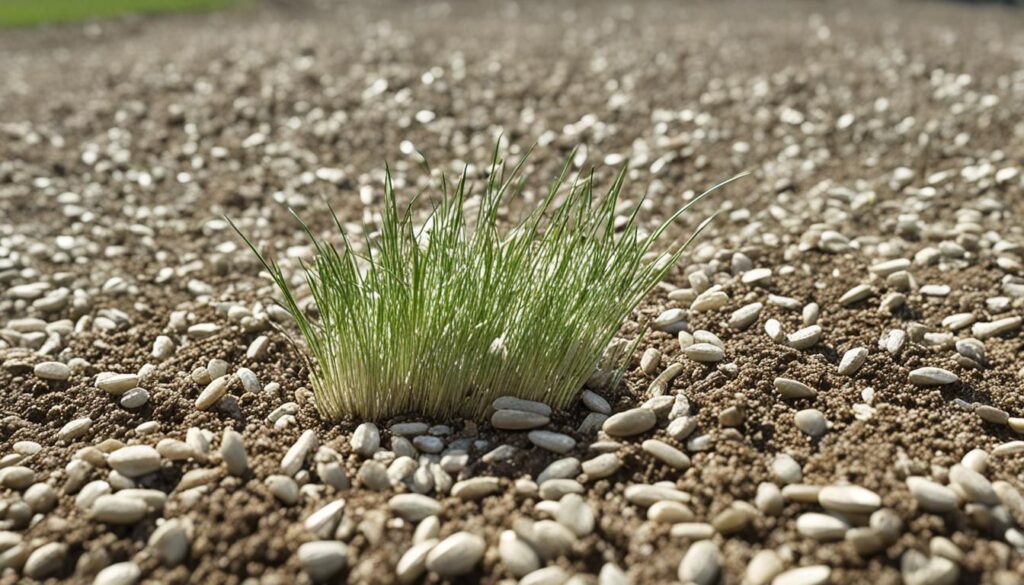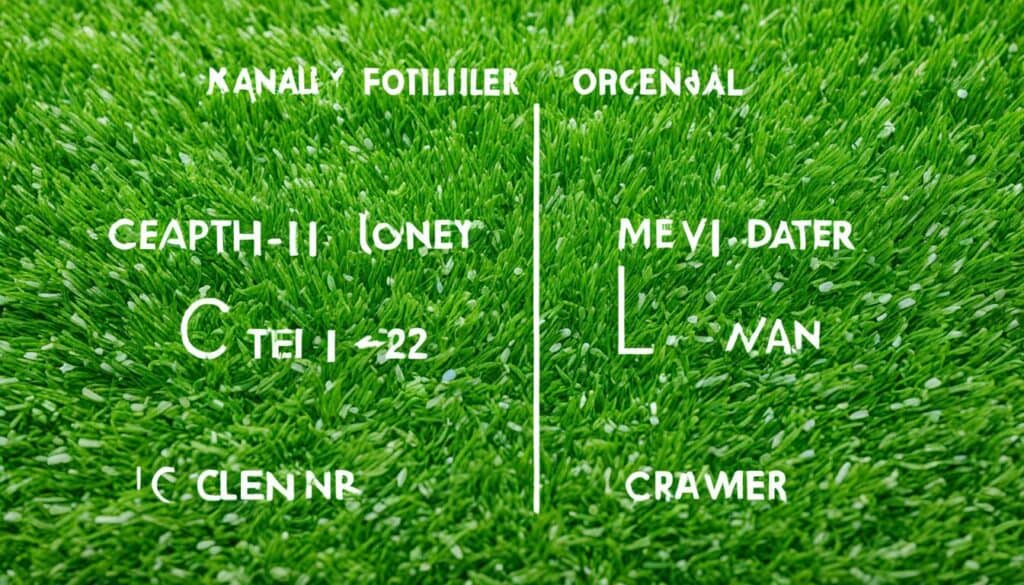Ever wondered how to keep your lawn green even in the cold months? Many think their grass sleeps through winter, needing no care. But, winterizing your lawn with the right fertilizer can make a big difference in spring. With so many choices, picking the best winter grass fertilizer for your lawn can be tough.
This guide will cover all you need to know about winter lawn fertilization. We’ll talk about the nutrients your grass needs to get through the cold. Plus, we’ll share our top picks for cool season grass fertilizers and dormant grass fertilizers. Whether your lawn is cool-season or warm-season, we’ve got expert advice and product suggestions to keep your yard looking great all year.
Key Takeaways
- Winter fertilizers are applied in fall and contain nitrogen, phosphorus, and potassium for grass health.
- Cool-season grasses need a winter fertilizer high in nitrogen with some potassium.
- Warm-season grasses require a fertilizer high in potassium with little to no nitrogen.
- The best time to apply winter fertilizer is when grass starts to go dormant but is still green.
- Choosing the right winter fertilizer formula and timing application correctly are key to a healthy spring lawn.
Understanding Winter Fertilization for Lawns
Winter fertilizing is key to keeping your lawn healthy and green all year. Many people fertilize in spring and summer, but late fall fertilizing is also crucial. It helps your lawn in the next growing season. Knowing about winter fertilizing and the differences between summer and winter fertilizers can help you make a good fertilizing plan.
Importance of Winter Fertilization
Winter fertilizing is important for several reasons. It helps your grass grow strong roots, which are key for getting nutrients and staying healthy. Even when growth slows down in winter, roots keep developing. Giving your lawn nutrients in winter means it grows deep, healthy roots that support green growth in spring.
Also, winter fertilizing lets your lawn store nutrients like carbohydrates. These are energy reserves that help the grass survive winter and come back strong when it gets warmer. A well-fertilized lawn in winter fights off diseases, pests, and stress, leading to a healthier lawn in spring and summer.
Differences Between Summer and Winter Fertilization
Summer and winter fertilizers both give your lawn nutrients, but they’re different. Summer fertilizers have more nitrogen, which makes the grass grow and look green. Winter fertilizers have more potassium, which makes the grass cells strong against cold, disease, and drought.
When you apply fertilizers also matters. Summer fertilizers go on every 6-8 weeks when the grass is growing. Winter fertilizers go on in late fall, just before the grass stops growing. This way, the grass gets nutrients and stores them for winter, starting strong in spring.
| Summer Fertilizers | Winter Fertilizers |
|---|---|
| Higher nitrogen content for leaf growth | Higher potassium content for cold and disease resistance |
| Applied every 6-8 weeks during active growing season | Applied in late fall before grass dormancy |
| Promotes deep green color | Strengthens cell walls and root system |
Understanding winter fertilizing and its differences with summer fertilizers helps you make a good plan. Choosing the right fertilizer and applying it at the best time keeps your lawn healthy and green all year. This makes your lawn the talk of the town.
Nutrients Essential for Winter Lawn Care
To keep your lawn healthy and green during winter, it’s key to give it the right nutrients. These nutrients help your lawn survive the cold and look great in spring. When picking a winter fertilizer, focus on nitrogen, phosphorus, and potassium.
Nitrogen
Nitrogen is crucial for keeping your lawn green and leafy. It helps your grass store food for winter and spring. Slow-release fertilizers often have more nitrogen for this purpose. But, some places limit nitrogen in fertilizers to protect the environment.
Phosphorus
Phosphorus helps roots grow strong, making your grass more resilient in winter. Yet, phosphorus use is limited in some places because it can harm waterways if used too much.
Potassium
Potassium boosts your lawn’s health and toughness, especially after summer stress like heavy use or drought. Potassium in winter fertilizers makes your grass stronger against diseases, cold, and winter damage.
Winter fertilizers have a three-number code on them, showing the NPK ratio. This tells you the nitrogen, phosphorus, and potassium levels. A common ratio is 21-0-20, focusing on nitrogen and potassium. But, the best ratio depends on your lawn and local rules.
| Nutrient | Function | Ideal Percentage |
|---|---|---|
| Nitrogen | Promotes green, leafy growth and carbohydrate storage | 21% |
| Phosphorus | Supports root development and growth | 0% |
| Potassium | Improves overall health, resilience, and winter hardiness | 20% |
Knowing what each nutrient does and choosing the right NPK ratio in your fertilizer helps your lawn get what it needs for winter and spring.
Choosing the Right Winter Fertilizer for Your Grass Type
When picking the best lawn fertilizer for winter, think about the type of grass you have. Different grasses need different nutrients. Knowing what your grass needs helps you pick the right winter fertilizer.
Cool-Season Grasses
Cool-season grasses like fescue, bluegrass, bent grass, and ryegrass do well in cold winters and mild summers. They do best with a fertilizer in early to late fall. Look for a winter fertilizer with lots of nitrogen and some potassium.
Nitrogen helps the grass build up and store carbs before it freezes. Potassium makes the grass more resistant to freezing and strengthens its roots.
A good fertilizer mix for cool-season grasses is 28-0-6. This means 28% nitrogen, 0% phosphorous, and 6% potassium. You should apply about 2-2 1/2 pounds of nitrogen per thousand square feet in late fall.
Cool-season grasses grow their roots most in early fall. This is the best time to fertilize them.
Warm-Season Grasses
Warm-season grasses, like Bermuda grass, zoysia, St. Augustine, centipede, and Bahia, are for areas with hot summers and mild winters. They do well with a fertilizer in early fall that’s high in potassium but has little or no nitrogen. Potassium prepares the grass for dormancy and boosts its health.
To figure out what your warm-season grass needs, get a soil test. This will show you any nutrient gaps and help you pick the best winter fertilizer.
| Grass Type | Best Fertilization Time | Recommended Fertilizer Ratio |
|---|---|---|
| Cool-Season Grasses (Fescue, Bluegrass, Bent Grass, Ryegrass) | Early to Late Fall | High Nitrogen, Some Potassium (e.g., 28-0-6) |
| Warm-Season Grasses (Bermuda, Zoysia, St. Augustine, Centipede, Bahia) | Early Fall | High Potassium, Little or No Nitrogen (based on soil test) |
Choosing the right winter fertilizer for your grass type ensures your lawn gets the nutrients it needs to make it through winter. This way, your lawn will be healthy and look great come spring.
Organic vs. Synthetic Winter Fertilizers
Choosing the right fertilizer for your lawn in winter can be tough. You might wonder if to pick organic or synthetic fertilizers. Each type has its pros and cons. Knowing these can help you decide better.
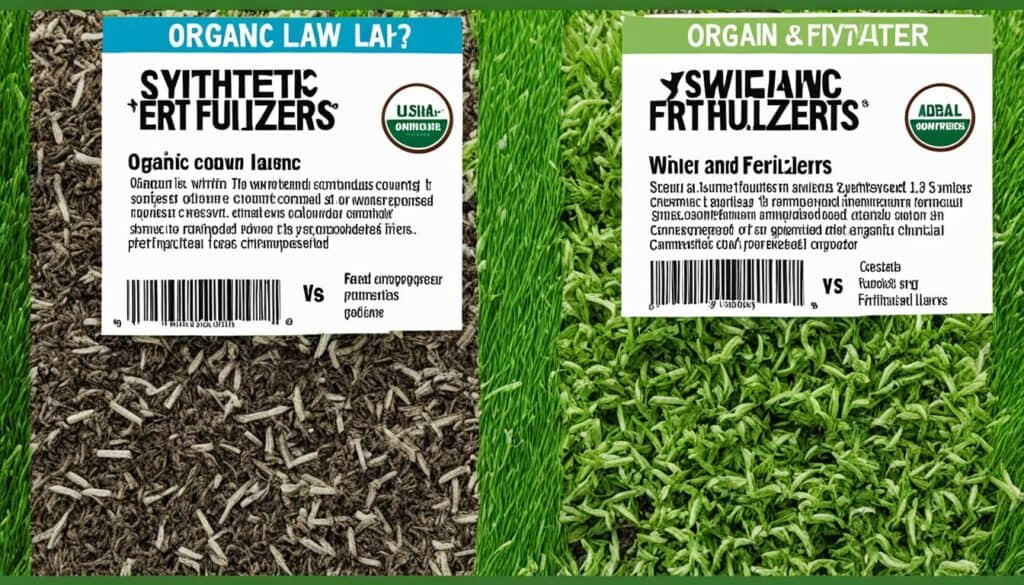
Organic fertilizers come from natural stuff like plants or animals. They help make soil healthier and more sustainable. They give nutrients slowly, which is good for your grass. But, they might take longer to work than synthetic ones.
Synthetic fertilizers are made and have the nutrients your lawn needs in the right amounts. They work fast to make your lawn green and healthy. But, they can make your lawn grow too fast, which might cause thatch if not watched closely.
“Synthetic fertilizers do not significantly alter lignin phenol and Soil Organic Carbon (SOC) concentrations over a 30-year application period.” – Li et al. (2020)
Looking at soil health over time, organic fertilizers are better. Studies show they increase soil health and turfgrass growth. Organic fertilizers also make soil healthier, as seen in Lima et al. (2009).
| Characteristic | Organic Winter Fertilizers | Synthetic Winter Fertilizers |
|---|---|---|
| Nutrient Release | Slow and steady | Fast-acting |
| Soil Health Impact | Improves soil structure and health | Minimal long-term impact on soil |
| Cost | Generally more expensive | Typically less expensive |
| Environmental Impact | Eco-friendly and sustainable | Potential for chemical runoff |
Choosing between organic and synthetic fertilizers depends on your lawn, budget, and the environment. If you want quick results and are watching your wallet, go for synthetic. But, if you care about soil health and the planet, choose organic. Think about what your lawn needs and talk to a lawn care pro to pick the best winter fertilizer.
Best Fertilizer for Grass in Winter
Finding the right winter lawn fertilizer is key to keeping your grass healthy. We looked at over 20 top winter fertilizers for grass. Here are our top picks:
Espoma Organic Lawn Food Fall Winterizer
Espoma Organic Lawn Food Fall Winterizer is great for those who want a natural option. It has an NPK ratio of 8-0-5, giving your lawn the right nutrients for winter. This 30-pound bag can feed up to 5,000 square feet, making it a good deal for big lawns.
Ace Winterizer All-Purpose Lawn Fertilizer
For a budget-friendly choice, try the Ace Winterizer All-Purpose Lawn Fertilizer. It has an NPK ratio of 28-0-10 and is phosphorus-free. This 42.9-pound package covers 15,000 square feet, making sure your whole lawn gets what it needs.
Milorganite 6-4-0 Slow-Release Nitrogen Fertilizer
Milorganite 6-4-0 is versatile, good for lawns, flowers, veggies, trees, and shrubs. It’s an organic nitrogen fertilizer with an NPK ratio of 6-4-0. The 32-pound bag covers 2,500 square feet and is safe for pets and the environment.
Purely Organic Products Lawn Food 10-0-2
Purely Organic Products Lawn Food 10-0-2 focuses on organic ingredients. It’s phosphate-free with an NPK ratio of 10-0-2, giving your lawn potassium to fight winter diseases. It’s a great choice for those who care about the planet.
| Fertilizer | NPK Ratio | Quantity | Coverage |
|---|---|---|---|
| Espoma Organic Lawn Food Fall Winterizer | 8-0-5 | 30 lbs | 5,000 sq ft |
| Ace Winterizer All-Purpose Lawn Fertilizer | 28-0-10 | 42.9 lbs | 15,000 sq ft |
| Milorganite 6-4-0 Slow-Release Nitrogen Fertilizer | 6-4-0 | 32 lbs | 2,500 sq ft |
| Purely Organic Products Lawn Food 10-0-2 | 10-0-2 | N/A | N/A |
When picking a winter fertilizer, think about your grass type, soil, and local laws on nitrogen and phosphorus use.
Choosing one of these top winter fertilizers and applying it right can help your lawn survive the cold. Your lawn will come back strong and green in spring.
Timing Your Winter Fertilizer Application
The best time to fertilize your lawn in winter is just before the first frost in late fall. This lets the nutrients strengthen the roots before the grass goes dormant. Check the soil temperature and aim for around 55°F (13°C) for the best results.
It’s important not to fertilize on frozen ground or right before heavy rain. Frozen soil stops the nutrients from reaching the roots. Heavy rain can also wash away the fertilizer before it soaks into the soil. By timing your application right, you make sure your lawn gets the most from the winter fertilizer.
Ideal Temperature Range
The best soil temperature for winter fertilizer is between 40-45°F (4-7°C). At these temperatures, the grass can still take in nutrients well. If the soil is too cold, the fertilizer might not work right or could cause problems when it gets warmer.
| Soil Temperature (°F) | Soil Temperature (°C) | Application Timing |
|---|---|---|
| 55 | 13 | Optimal timing for winter fertilizer application |
| 40-45 | 4-7 | Ideal temperature range for winter fertilizer application |
| Below 40 | Below 4 | Too cold for effective nutrient absorption |
Considerations for Newly Seeded or Sodded Lawns
If you’ve recently seeded or sodded your lawn, you need to think about what your new grass needs. Some fertilizers, like Scotts Turf Builder WinterGuard Fall Weed and Feed, are for established lawns only. Don’t use them on new sod or seeded areas.
Wait to fertilize new lawns until the grass has been mowed at least two to three times. This lets the grass grow strong roots that can take in the fertilizer better. If you’re unsure, check the product label or talk to a local lawn care expert for advice.
Proper Application Techniques for Winter Fertilizers
When fertilizing your lawn in winter, it’s key to apply it right for the best results. Start by mowing your lawn and clearing it of debris. This ensures the fertilizer spreads evenly. Use a spreader for uniform coverage and follow the product’s guidelines for settings and rates.
Spread the fertilizer in a criss-cross pattern for full coverage. Then, lightly water the lawn to help the nutrients soak in. But, don’t over-water, as it can cause runoff and waste the fertilizer. If fertilizer ends up on hard surfaces, sweep it back onto the lawn to prevent pollution and boost effectiveness.
Always wear gloves when handling fertilizer and store it safely away from children and pets to stay safe.
When to apply winter fertilizer is also crucial. Do it late in the fall, right before the first frost. This lets the nutrients work on the soil and strengthen roots before they go dormant. Make sure the soil temperature is between 55 to 70 degrees Fahrenheit for the best results. Don’t apply fertilizer if the ground is frozen, as it won’t soak in well.
| Grass Type | Recommended Winter Fertilizer | Application Time |
|---|---|---|
| Cool-season grasses (Tall Fescue, Kentucky Bluegrass, Rye) | Almighty 20-0-10 Lawn Fertilizer | Late fall, just before first frost |
| Tall Fescue | Lesco 32-0-3 Fertilizer | November or December |
| Warm-season grasses | Not recommended | N/A |
Choose slow-release fertilizers for your winter lawn care. These types feed your lawn steadily over time. It’s also smart to test your soil before fertilizing to see what nutrients your lawn needs most.
By using these tips and applying winter fertilizer correctly, you’ll keep your lawn looking great all winter. Your lawn will be the talk of the town come spring.
Common Mistakes to Avoid When Fertilizing in Winter
Winter lawn fertilizer mistakes can harm your grass. To keep your lawn healthy in spring, avoid these common errors. Knowing the pitfalls helps you maintain your lawn’s health during the cold season.
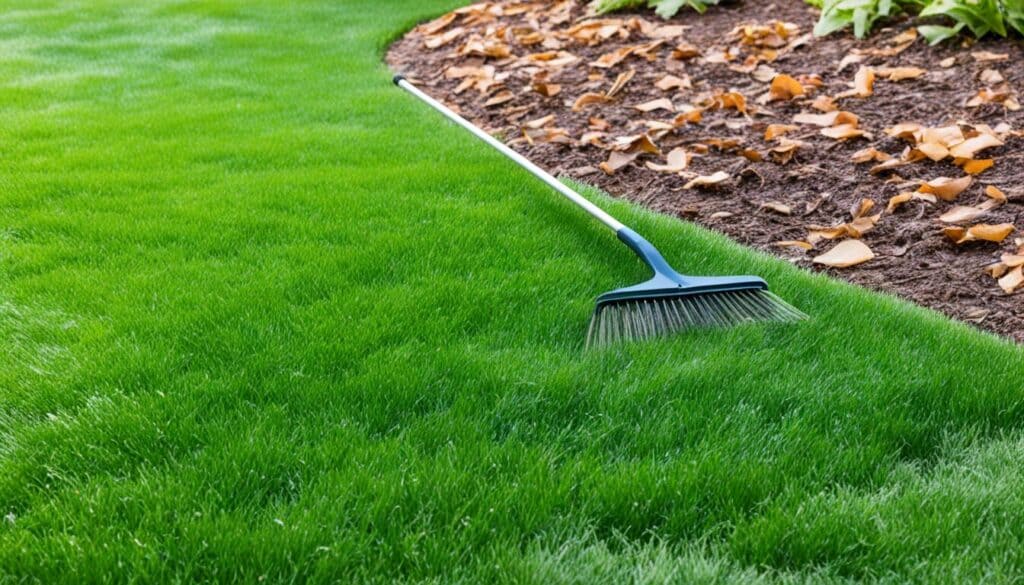
Overfertilization
Overfertilizing is a big mistake. Too much fertilizer can cause problems like fertilizer burn, too much growth, and harm the environment. In Lakeway, TX, experts say overfertilizing is a top mistake for winter lawn care. Always use the right amount and follow the recommended rates to avoid issues.
Applying Fertilizer on Frozen Ground
Don’t apply fertilizer on frozen ground. The nutrients won’t reach the soil, and the grass can’t absorb them. This can pollute nearby water sources. Wait for the ground to thaw before fertilizing. Also, be careful with extreme temperatures, as they’re not good for applying fertilizer.
Other mistakes to avoid include:
- Skipping a soil test, which can lead to wrong fertilizer use or unnecessary nutrients
- Ignoring local fertilizer use laws, which can cause fines and environmental damage
- Not cleaning up spills, letting fertilizer flow into drains and waterways
- Using the wrong fertilizer, which can severely harm the lawn
- Improper watering after fertilizing, preventing nutrient absorption
For the best results, follow these tips:
- Use fertilizers with 50% slow-release nitrogen content
- Choose products like Lesco 21-0-21 with 75% polyplus for winterizing
- Avoid fertilizers high in potassium to prevent snow mold, as studies link it to increased snow mold risks
- Use fast-release nitrogen sources like urea for winterizing
- Rake snow mold-affected areas for recovery in spring
- Apply granular fertilizer over spraying for winterization
- Consider using a fertilizer with a 10-0-20 ratio for late applications in early November
Avoid these winter lawn fertilizer mistakes and follow best practices. This way, you can keep your lawn healthy and enjoy a beautiful outdoor space in spring.
Maintaining a Healthy Lawn Throughout Winter
Applying the best fertilizer for grass in winter is key, but it’s not the only thing you need to do. Proper winter lawn care means doing a mix of things to help your grass make it through the cold season strong and ready for spring.
Mowing Practices
Before winter comes, make sure to mow your lawn to the right height for your grass type. Tall grass can get matted down by snow, making it more likely to get diseases. But cutting it too short can weaken the roots and make them cold-sensitive. Find the best mowing height for your grass and keep it there until the last cuts of the season.
It’s also key to keep off your grass when it’s frozen or dormant. Walking on frozen grass can break the blades, causing damage that might not fix until spring. If you need to walk on your lawn, try to do it lightly and avoid making paths.
Weed Control
Weeds can be a problem in winter, especially with cool-season annuals like chickweed and henbit. To stop these weeds, use a pre-emergent herbicide in late fall. This stops weed seeds from growing, cutting down on the need for weed control in spring.
There are also cultural ways to fight weeds in winter. Clean up fallen leaves and debris often to let sunlight get to your grass and stop weed seeds from germinating. Fix any drainage problems before winter to stop water from pooling and making weeds grow.
| Winter Lawn Care Practice | Benefit |
|---|---|
| Mow to recommended height | Prevents snow mold and other diseases |
| Minimize foot traffic | Avoids damage to frozen grass blades |
| Apply pre-emergent herbicide | Prevents winter annual weeds from germinating |
| Remove leaves and debris | Allows sunlight to reach grass and discourages weeds |
| Address drainage issues | Prevents standing water that encourages weed growth |
By following these winter lawn care tips and using the best fertilizer for grass in winter, you’re setting your lawn up for success in spring. A full plan for winter lawn care will lead to a healthier, more resilient lawn. This lawn will be ready to face the cold months and bounce back quickly when it gets warmer.
Conclusion
Choosing the right winter fertilizer is key to keeping your lawn healthy and green during the cold months. Pick a fertilizer that fits your grass type and apply it in late fall for the best results. Make sure to check the NPK ratio and follow local fertilizer laws.
Great options for winter lawn care include Espoma Organic Lawn Food Fall Winterizer and Ace Winterizer All-Purpose Lawn Fertilizer. You can also consider Milorganite 6-4-0 Slow-Release Nitrogen Fertilizer and Purely Organic Products Lawn Food 10-0-2. Whether you prefer organic or synthetic fertilizers, there’s a good choice for you.
When applying fertilizer, avoid mistakes like overdoing it or putting it on frozen ground. Stick to proper application methods and keep up with regular mowing and weed control. Following this guide will help your lawn stay healthy and ready to grow when spring comes.
FAQ
What are the best winter fertilizers for cool-season grasses?
For cool-season grasses, use fertilizers with lots of nitrogen and some potassium. Good options include Espoma Organic Lawn Food Fall Winterizer or Ace Winterizer All-Purpose Lawn Fertilizer.
When should I apply winter fertilizer to my lawn?
Apply winter fertilizer in late fall, just before the first frost. Soil temperatures should be around 55°F. This helps the nutrients strengthen roots before the grass goes dormant.
How do winter fertilizers differ from summer fertilizers?
Winter fertilizers have more nitrogen for cool-season grasses and more potassium for warm-season grasses. They are applied in late fall, when the grass is dormant.
Can I use the same winter fertilizer for both cool-season and warm-season grasses?
No, cool-season and warm-season grasses need different winter fertilizers. Cool-season grasses require high nitrogen and some potassium. Warm-season grasses need more potassium and little or no nitrogen.
Are organic winter fertilizers better than synthetic options?
Both organic and synthetic winter fertilizers work well, depending on your lawn and preferences. Organic fertilizers boost soil health and release nutrients slowly. Synthetic fertilizers provide nutrients quickly but can be risky if used too much.
What are some common mistakes to avoid when fertilizing in winter?
Avoid overfertilizing, applying to frozen ground, skipping soil tests, ignoring local fertilizer laws, and not cleaning spills. Always follow the recommended amounts and wait for the ground to thaw before fertilizing.
How can I maintain a healthy lawn throughout winter?
For a healthy winter lawn, mow before winter, limit foot traffic, and control weeds with pre-emergent herbicides in late fall. Fix drainage issues and remove leaves and debris.

